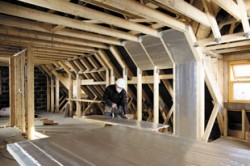Chris Hall, Chief Executive at the British Rigid Urethane Foam Manufacturer’s Association (BRUFMA), describes how stringent legislation and government advice on insulation requirements has affected the creation of an airtight and thermally efficient timber frame building.
At the heart of some of the oldest homes in the UK and offering a wealth of benefits to contractors and homeowners from design flexibility to reduced build times, timber frame construction is one of the most cost effective and environmentally friendly construction methods. Timber is carbon neutral in its production – unlike bricks and mortars, the manufacture of which account for 4% of global CO2 emissions. As a result it is frequently partnered with high performance PIR insulation boards to form an integrated building frame and envelope with minimal environmental impact.
This popular insulation method has many desirable performance qualities. Exceptionally lightweight, it has an excellent strength to weight ratio. It is moisture resistant ensuring longstanding performance and providing a level of flood resilience not offered by many other insulation types. The performance properties of PIR insulation boards have seen them frequently specified on timber frame buildings due to their cost effective, long term and high performance qualities.
The efficiency of the building fabric through efficient U-values, detailing and airtightness remains the starting point for a highly efficient timber frame home. With a thickness of between 25mm to 200mm, rigid PIR insulation boards can provide one of the thinnest solutions to the requirements of Approved Document L1A, and can provide the optimum solution in terms of space, costs, transportation and handling.
Timber frame constructions can be insulated to very low U-values through the use of rigid board insulations. With lambda values as low as 0.021 W/mK, equivalent insulation performance can be achieved with less thickness than other commonly used insulation materials. Furthermore, insulation systems with an unbridged insulation layer are seen as best practice as they minimise repeating any linear thermal bridges and their consequences.
With sizes up to 2400mm x 1200mm, PIR insulation boards are robust enough to withstand the rigours of a modern construction site whilst still being easy to handle and cut to measure. When combined with their lightweight, this makes it easier to obtain a quick, easy and correct installation. Meeting Building Regulations in respect of approved document B (Fire), the use of PIR insulation in timber frame construction also does not compromise the fire performance.
Over the years BRUFMA has built up a great deal of credibility with many government and non-governmental organisations (NGOs) involved in the legislative areas affecting the production and use of PIR/PUR insulation products. Providing insulation for houses is one of the simplest and easiest ways to reduce our energy consumption, combat climate change and ensure they are warm and weathertight. This is especially the case with regards to timber frame construction, one of the fastest growing options for new home construction in the UK.
For more information about BRUFMA visit www.brufma.co.uk
Timber Frame & Rigid Insulation
21st January, 2016









